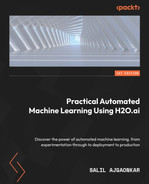Previous Chapter
Practical Automated Machine Learning Using H2O.ai Copyright © 2022 Packt Publishing
Table of Contents
Preface
Part: 1H2O AutoML Basics
1
Understanding H2O AutoML Basics
Technical requirements
Understanding AutoML and H2O AutoML
AutoML
H2O AutoML
Minimum system requirements to use H2O AutoML
Installing Java
Basic implementation of H2O using Python
Installing Python
Installing H2O using Python
Basic implementation of H2O using R
Installing R
Installing H2O using R
Training your first ML model using H2O AutoML
Understanding the Iris flower dataset
Model training
Summary
2
Working with H2O Flow(H2O’s Web UI)
Technical requirements
Understanding the basics of H2O Flow
Downloading and launching H2O Flow
Exploring H2O Flow
Working with data functions in H2O Flow
Importing the dataset
Parsing the dataset
Observing the dataframe
Splitting a dataframe
Working with model training functions in H2O Flow
Understanding the AutoML parameters in H2O Flow
Training and understanding models using AutoML in H2O Flow
Working with prediction functions in H2O Flow
Making predictions using H2O Flow
Understanding the prediction results
Summary
Part 2: H2O AutoMLDeep Dive
3
Understanding Data Processing
Technical requirements
Reframing your dataframe
Combining columns from two dataframes
Combining rows from two dataframes
Merging two dataframes
Handling missing values in the dataframe
Filling NA values
Replacing values in a frame
Imputation
Manipulating feature columns of the dataframe
Sorting columns
Changing column types
Tokenization of textual data
Encoding data using target encoding
Summary
4
Understanding H2O AutoML Architecture and Training
Observing the high-level architecture of H2O
Observing the client layer
Observing the JVM component layer
Learning about the flow of interaction between the client and the H2O service
Learning about H2O client-server interactions during the ingestion of data
Knowing the sequence of interactions in H2O during model training
Understanding how H2O AutoML performs hyperparameter optimization and training
Understanding hyperparameters
Understanding hyperparameter optimization
Summary
5
Understanding AutoML Algorithms
Understanding the different types of ML algorithms
Understanding the Generalized Linear Model algorithm
Introduction to linear regression
Understanding the assumptions of linear regression
Working with a Generalized Linear Model
Understanding the Distributed Random Forest algorithm
Introduction to decision trees
Introduction to Random Forest
Understanding Extremely Randomized Trees
Understanding the Gradient Boosting Machine algorithm
Building a Gradient Boosting Machine
Understanding what is Deep Learning
Understanding neural networks
Summary
6
Understanding H2O AutoML Leaderboard and Other Performance Metrics
Exploring the H2O AutoML leaderboard performance metrics
Understanding the mean squared error and the root mean squared error
Working with the confusion matrix
Calculating the receiver operating characteristic and its area under the curve (ROC-AUC)
Calculating the precision-recall curve and its area under the curve (AUC-PR)
Working with log loss
Exploring other model performance metrics
Understanding the F1 score performance metric
Calculating the absolute Matthews correlation coefficient
Measuring the R2 performance metric
Summary
7
Working with Model Explainability
Technical requirements
Working with the model explainability interface
Implementing the model explainability interface in Python
Implementing the model explainability interface in R
Exploring the various explainability features
Understanding residual analysis
Understanding variable importance
Understanding feature importance heatmaps
Understanding model correlation heatmaps
Understanding partial dependency plots
Understanding SHAP summary plots
Understanding individual conditional expectation plots
Understanding learning curve plots
Summary
Part 3: H2O AutoML Advanced Implementation and Productization
8
Exploring Optional Parameters for H2O AutoML
Technical requirements
Experimenting with parameters that support imbalanced classes
Understanding undersampling the majority class
Understanding oversampling the minority class
Working with class balancing parameters in H2O AutoML
Experimenting with parameters that support early stopping
Understanding early stopping
Working with early stopping parameters in H2O AutoML
Experimenting with parameters that support cross-validation
Understanding cross-validation
Working with cross-validation parameters in H2O AutoML
Summary
9
Exploring Miscellaneous Features in H2O AutoML
Technical requirements
Understanding H2O AutoML integration in scikit-learn
Building and installing scikit-learn
Experimenting with scikit-learn
Using H2O AutoML in scikit-learn
Understanding H2O AutoML event logging
Summary
10
Working with Plain Old Java Objects (POJOs)
Technical requirements
Introduction to POJOs
Extracting H2O models as POJOs
Downloading H2O models as POJOs in Python
Downloading H2O models as POJOs in R
Downloading H2O models as POJOs in H2O Flow
Using a H2O model as a POJO
Summary
11
Working with Model Object, Optimized (MOJO)
Technical requirements
Understanding what a MOJO is
Extracting H2O models as MOJOs
Extracting H2O models as MOJOs in Python
Extracting H2O models as MOJOs in R
Extracting H2O models as MOJOs in H2O Flow
Viewing model MOJOs
Using H2O AutoML model MOJOs to make predictions
Summary
12
Working with H2O AutoML and Apache Spark
Technical requirements
Exploring Apache Spark
Understanding the components of Apache Spark
Understanding the Apache Spark architecture
Understanding what a Resilient Distributed Dataset is
Exploring H2O Sparkling Water
Downloading and installing H2O Sparkling Water
Implementing Spark and H2O AutoML using H2O Sparkling Water
Summary
13
Using H2O AutoML with Other Technologies
Technical requirements
Using H2O AutoML and Spring Boot
Understanding the problem statement
Designing the architecture
Working on the implementation
Using H2O AutoML and Apache Storm
What is Apache Storm?
Understanding the problem statement
Designing the architecture
Working on the implementation
Summary
Index
Other Books You May Enjoy
..................Content has been hidden....................
You can't read the all page of ebook, please click here login for view all page.
